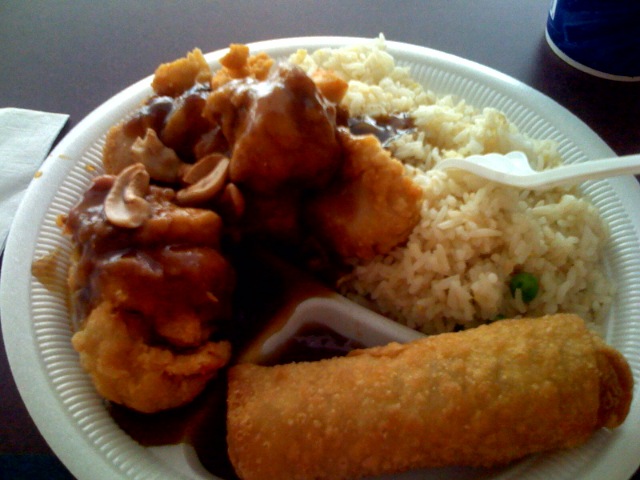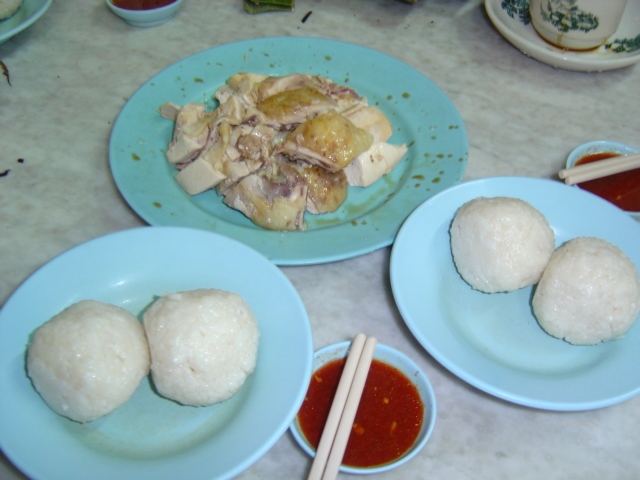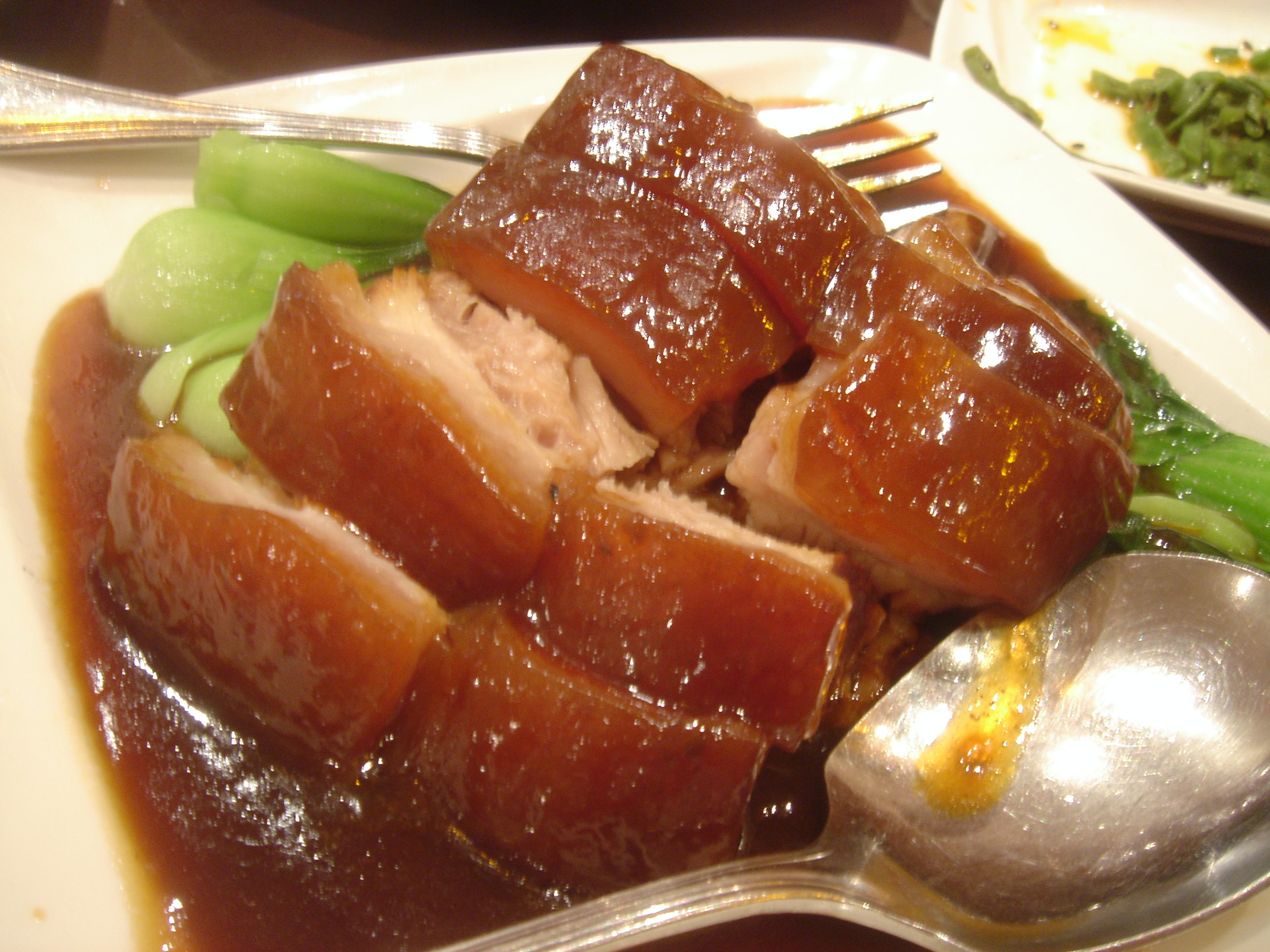|
Oyster Sauce
Oyster sauce describes a number of sauces made by cooking oysters. The most common in modern use is a viscous dark brown condiment made from oyster extracts,The Times, 22 January 1981; ''Cook Accidentally on purpose'' sugar, salt and water thickened with corn starch. Some versions may be darkened with caramel, though high-quality oyster sauce is naturally dark.BigOven Food DictionaryOyster sauce' It is commonly used in Chinese, Thai, Malay, Vietnamese, and Khmer cuisine. Production Oyster sauce production began in China no later than the mid-1870s. Oysters were boiled in three iron basins for half an hour then removed for drying on rattan either by sun or over a moderate fire. The water from the basins was reduced in a fourth basin to "a blackish sauce". Sea-water, salt and/or soy could be added. Today, many shortcuts have been made to create a similar flavor more quickly and at reduced cost. Oyster sauces today are usually made with a base of sugar and salt and thickene ... [...More Info...] [...Related Items...] OR: [Wikipedia] [Google] [Baidu] |
Oyster
Oyster is the common name for a number of different families of salt-water bivalve molluscs that live in marine or brackish habitats. In some species, the valves are highly calcified, and many are somewhat irregular in shape. Many, but not all oysters are in the superfamily Ostreoidea. Some types of oysters are commonly consumed (cooked or raw), and in some locales are regarded as a delicacy. Some types of pearl oysters are harvested for the pearl produced within the mantle. Windowpane oysters are harvested for their translucent shells, which are used to make various kinds of decorative objects. Etymology The word ''oyster'' comes from Old French , and first appeared in English during the 14th century. The French derived from the Latin , the feminine form of , which is the latinisation of the Ancient Greek () 'oyster'. Compare () 'bone'. Types True oysters True oysters are members of the family Ostreidae. This family includes the edible oysters, which mainly b ... [...More Info...] [...Related Items...] OR: [Wikipedia] [Google] [Baidu] |
Cantonese Cuisine
Cantonese or Guangdong cuisine, also known as Yue cuisine ( or ) is the cuisine of Guangdong province of China, particularly the provincial capital Guangzhou, and the surrounding regions in the Pearl River Delta including Hong Kong and Macau.Hsiung, Deh-Ta. Simonds, Nina. Lowe, Jason. 005(2005). The food of China: a journey for food lovers. Bay Books. . p17. Strictly speaking, Cantonese cuisine is the cuisine of Guangzhou or of Cantonese speakers, but it often includes the cooking styles of all the speakers of Yue Chinese languages in Guangdong. Scholars categorize Guangdong cuisine into three major groups based on the region's dialect: Cantonese, Hakka and Chaozhou cuisines. The Teochew cuisine and Hakka cuisine of Guangdong are considered their own styles, as is neighboring Guangxi's cuisine despite eastern Guangxi being considered culturally Cantonese due to the presence of ethnic Zhuang influences in the rest of the province. Cantonese cuisine is one of the Eight Culi ... [...More Info...] [...Related Items...] OR: [Wikipedia] [Google] [Baidu] |
Lo Mein
Lo mein () is a Chinese dish with egg noodles. It often contains vegetables and some type of meat or seafood, usually beef, chicken, pork, or shrimp. It might also be served with wontons (called ''húntun'' 餛飩/馄饨 in Mandarin) although wontons are usually a soup ingredient. It can also be eaten with just vegetables. Traditionally this is a dry variation of noodle soup. The soup is simply separated from the noodles and other ingredients and served on the side. Etymology The term ''lo mein'' comes from the Cantonese ''lou1 min6'' (), meaning "stirred noodles". The Cantonese use of the character 撈, pronounced ''lou1'' and meaning "to stir", in its casual form, differs from the character's traditional Han meaning of "to dredge" or "to scoop out of water" in Mandarin, in which case it would be pronounced as ''laau4'' or ''lou4'' in Cantonese (''lāo'' in Mandarin). In Mandarin, the dish is called ''lāo miàn''. In its country of origin, it is made of thin flour-and-egg no ... [...More Info...] [...Related Items...] OR: [Wikipedia] [Google] [Baidu] |
Cashew Chicken
Cashew chicken () is a Chinese-American dish that combines chicken (usually stir-fried but occasionally deep-fried, depending on the variation), with cashews and either a light brown garlic sauce or a thick sauce made from chicken stock, soy sauce and oyster sauce. Traditional cashew chicken The traditional version of cashew chicken is stir-fried in a wok. Tender chunks of chicken are combined with crispy roasted cashews, vegetables and are tossed in a light sauce made from garlic, soy sauce and hoisin sauce, thinned with water. Springfield-style cashew chicken The deep-fried version of the dish is closely associated with the city of Springfield, Missouri. Deep-fried cashew chicken was apparently first served in 1963 at the Grove Supper Club in Springfield. David Leong (1920–2020), a chef who moved to the United States from China in 1940, struggled to gain acceptance for the foods of his homeland so he began searching for a dish that would appeal to local residents' taste ... [...More Info...] [...Related Items...] OR: [Wikipedia] [Google] [Baidu] |
Hainanese Chicken Rice
Hainanese chicken rice is a dish of poached chicken and seasoned rice, served with chilli sauce and usually with cucumber garnishes. It was created by immigrants from Hainan in southern China and adapted from the Hainanese dish Wenchang chicken. It is considered one of the national dishes of Singapore and is most commonly associated with Singaporean cuisine, being widely available in most food courts and hawker centres around the country. Variants of the dish can also be seen throughout Southeast Asia, particularly in Malaysia and Thailand, where it remains a culinary staple. History Hainanese chicken rice is a dish adapted from early Chinese immigrants originally from Hainan province in southern China. It is based on a well-known Hainanese dish called Wenchang chicken (), which is one of four important Hainan dishes dating to the Qin dynasty. The Hainanese in China traditionally used a specific breed, the Wenchang chicken, to make the dish. They would usually cook rice wi ... [...More Info...] [...Related Items...] OR: [Wikipedia] [Google] [Baidu] |
Buddha's Delight
Buddha's delight, often transliterated as ''Luóhàn zhāi'', ''lo han jai'', or ''lo hon jai'', is a vegetarian dish well known in Chinese and Buddhist cuisine. It is sometimes also called ''Luóhàn cài'' (). The dish is traditionally enjoyed by Buddhist monks who are vegetarians, but it has also grown in popularity throughout the world as a common dish available as a vegetarian option in Chinese restaurants. The dish consists of various vegetables and other vegetarian ingredients (sometimes with the addition of seafood or eggs), which are cooked in soy sauce-based liquid with other seasonings until tender. The specific ingredients used vary greatly both inside and outside Asia. Etymology In the name ''luóhàn zhāi'', ''luóhàn'' – short for ''Ā luóhàn'' () – is the Chinese transliteration of the Sanskrit ''arhat'', meaning an enlightened, ascetic individual or the Buddha himself. ''Zhāi'' () means "vegetarian food" or "vegetarian diet." The dish is u ... [...More Info...] [...Related Items...] OR: [Wikipedia] [Google] [Baidu] |
Kai-lan
Gai lan, kai-lan, Chinese broccoli, Chinese kale, or jie lan (''Brassica oleracea'' var. ''alboglabra'') is a leaf vegetable with thick, flat, glossy blue-green leaves with thick stems, and florets similar to (but much smaller than) broccoli. A ''Brassica oleracea'' cultivar, gai lan is in the group ''alboglabra'' (from Latin ''albus'' "white" and ''glabrus'' "hairless"). When gone to flower, its white blossoms resemble that of its cousin ''Matthiola incana'' or Hoary Stock. The flavor is very similar to that of broccoli, but noticeably stronger and slightly more bitter. Hybrids Broccolini is a hybrid between broccoli and gai lan. Cultivation ''Gai lan'' can be sown in late summer for early-winter harvesting. Seedlings planted in autumn will last all winter. As with other brassicas, gai lan is harvested and consumed just as its white flowers start to bloom, as the stems can become woody and tough when the plant bolts. Uses ''Gai lan'' is eaten widely in Chinese cuisine, com ... [...More Info...] [...Related Items...] OR: [Wikipedia] [Google] [Baidu] |
Crab In Oyster Sauce
, country = China & Indonesia , region = East Asia and Southeast Asia notably: Indonesia, Philippines, Singapore , creator = Chinese cuisine , course = Main course , served = Hot , main_ingredient = Crab served in oyster sauce, garlic, ginger and scallion , variations = , calories = , other = Crab in oyster sauce or oyster sauce crab is a Chinese seafood dish of crab served in savoury oyster sauce. It is a popular dish in Asia, that can be found from China, Indonesia, Singapore to the Philippines. Origin Crab in oyster sauce can trace its origin to Southern China's Cantonese cuisine, more precisely, after the development of oyster sauce in the late 19th century. Then the dish was spread across Asia. In Indonesia, it is known as ''kepiting saus tiram'', one of the two most popular ways that crab is served there and a popular seafood in Chinese Indonesian cuisine. Ingredients The mos ... [...More Info...] [...Related Items...] OR: [Wikipedia] [Google] [Baidu] |
Zhejiang Cuisine
Zhejiang cuisine, alternatively known as Zhe cuisine, is one of the Eight Culinary Traditions of Chinese cuisine. Zhejiang cuisine contains four different styles, Hangzhou, Shaoxing, Ningbo, and Wenzhou (also known as Ou cuisine). It derives from the traditional ways of cooking in Zhejiang Province, which is located south of Shanghai and centred around Hangzhou, a historical Chinese capital. In general, Zhejiang cuisine is not greasy but has a fresh and soft flavour with a mellow fragrance. Styles Zhejiang cuisine consists of at least three styles, each originating from a major city in the province: * Hangzhou style: Characterised by rich variations and the use of bamboo shoots. It is served in restaurants such as the Dragon Well Manor. * Shaoxing style: Specialising in poultry and freshwater fish. * Ningbo style: Specialising in seafood, with emphasis on freshness and salty dishes. Some sources also include the Wenzhou style (Ou cuisine) as a separate subdivision due to ... [...More Info...] [...Related Items...] OR: [Wikipedia] [Google] [Baidu] |
Jiangsu Cuisine
Jiangsu cuisine (), also known as Su cuisine, is one of the Eight Culinary Traditions of Chinese cuisine. It is derived from the native cooking styles of Jiangsu Province. In general, Jiangsu cuisine's texture is characterised as soft, but not to the point of mushy or falling apart. In addition, Jiangsu cuisine also focuses on heating temperature. For example, the meat tastes quite soft but would not separate from the bone when picked up. As the style of Jiangsu cuisine is typically practised near the sea, fish is a very common ingredient in cooking. Other characteristics include the strict selection of ingredients according to the seasons, with emphasis on the matching colour and shape of each dish and using soup to improve flavour. The municipality of Shanghai was formerly a part of Jiangsu thus the great deal of similarity between the two, and Shanghai cuisine is sometimes classified as a part of Jiangsu cuisine. Regional variations Jiangsu cuisine is sometimes simply calle ... [...More Info...] [...Related Items...] OR: [Wikipedia] [Google] [Baidu] |
Red Cooking
Red cooking, also called Chinese stewing, red stewing, red braising, or flavor potting, is a slow braising Chinese cooking technique that imparts a reddish-brown coloration to the prepared food. There are two types of red cooking: *Hongshao (): can be done in less than 20 minutes and usually does not require much water *Lu (): usually requires prolonged cooking of up to several hours and the items must be submerged in the cooking liquid. Red cooking is popular throughout most of northern, eastern, and southeastern China. The name is derived from the dark red-brown coloration of the cooked items and its sauce. Types Soy sauce (usually a mix of light and dark soy sauce), fermented bean paste, red fermented tofu or rock sugar is commonly used to both flavor and impart a reddish brown hue to the items being cooked. Food coloring is sometimes added for a more intense red coloration. Both ''lu'' and ''hongshao'' are forms of stewing or braising characterized by usage of soy s ... [...More Info...] [...Related Items...] OR: [Wikipedia] [Google] [Baidu] |
Seafood
Seafood is any form of sea life regarded as food by humans, prominently including fish and shellfish. Shellfish include various species of molluscs (e.g. bivalve molluscs such as clams, oysters and mussels, and cephalopods such as octopus and squid), crustaceans (e.g. shrimp, crabs, and lobster), and echinoderms (e.g. sea cucumbers and sea urchins). Historically, marine mammals such as cetaceans (whales and dolphins) as well as seals have been eaten as food, though that happens to a lesser extent in modern times. Edible sea plants such as some seaweeds and microalgae are widely eaten as sea vegetables around the world, especially in Asia. Seafood is an important source of (animal) protein in many diets around the world, especially in coastal areas. Semi-vegetarians who consume seafood as the only source of meat are said to adhere to pescetarianism. The harvesting of wild seafood is usually known as fishing or hunting, while the cultivation and farming of seafood is kno ... [...More Info...] [...Related Items...] OR: [Wikipedia] [Google] [Baidu] |





.jpg)


